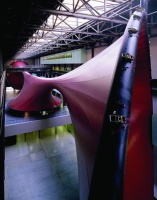Advanced geometry: engineering architecture at the Olympics
Super structure: Arup’s advanced geometry unit is set to construct a controversial tower in London’s Olympic Village. Stuart Nathan reports


The Fabwin system divided the surface of the membrane into a collection of node points, connected by triangles. Each triangle pulled on its three nodes with a constant force, which moved the nodes around. After iterating this process over and over again, the system reached a point where every node was being pulled on with an equal force, meaning they stopped moving and entered a stable shape. Altering the weight of the rings and ballast on the membrane, and the amount of stress, changed the stable form and allowed Kapoor to sculpt the shape he wanted.
Balmond’s team then had to install the sculpture, and settled on using the overhead gantries that support the Turbine Hall’s cranes. The sections of tubular steel that formed the lattice were formed into the huge rings using induction bending, and the rings suspended from the gantries at either end of the building. The concrete floor of the gallery took some of the weight, and two additional sections of steel tube for each ring passed some of the load onto the former power station’s roof structure.
Register now to continue reading
Thanks for visiting The Engineer. You’ve now reached your monthly limit of premium content. Register for free to unlock unlimited access to all of our premium content, as well as the latest technology news, industry opinion and special reports.
Benefits of registering
-
In-depth insights and coverage of key emerging trends
-
Unrestricted access to special reports throughout the year
-
Daily technology news delivered straight to your inbox










Water Sector Talent Exodus Could Cripple The Sector
Maybe if things are essential for the running of a country and we want to pay a fair price we should be running these utilities on a not for profit...